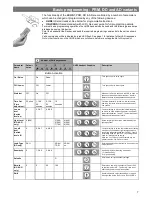
7
Basic programming - PRM, DD and AD variants
Parameter
Name
Default
Value
0
1
2
3
UHS5 Handset Graphics
Description
Button Activation
On / Raise
On
Raise
Turn lights on or to raise lights.
Off / Lower
Off
Lower
Turn lights off or to lower lights.
Walk test
Off
On
Off
When set to On this causes a red LED to flash on
the sensor when it detects movement. Use this
feature to check for adequate sensitivity levels.
Time Out
(Time
adjustment)
20 mins
1, 10 &
20
minutes
5, 15 &
30
minutes
10
seconds
Once the detector is turned on, this value sets
how long the lights will stay on once movement
has ceased.
Lux on
level
(Switch
level on)
9
2, 5 & 7
4, 6 & 9
Lux level setting to prevent the luminaires being
switched on if the ambient light level is sufficient
(adjustable between 1 and 9). The luminaires will
always be switched on at level 9.
Light Level
(DD & AD
only)
6 (600)
2 (200)
5 (500)
7 (700)
4 (400)
6 (600)
9 (900)
Sets a target light level to be maintained by the
lighting system.
Lux off
level
(Switch
level off)
9
2, 5 & 7
4, 6 & 9
Lux level setting to switch the luminaires off during
occupancy if the ambient light level goes above
the setting (adjustable between 1 and 9). Level 9
will always keep the lights on. This setting can be
used for “window row switching”.
Note: the Lux Off Level value must always be
greater than the Lux On Level value.
Load Type
(DD only)
DALI
2-DALI
7-DSI
2-DALI
on
Sets the ballast control protocol to be used by the
output channel.
Sensitivity
9
1, 5 & 9
3, 6 & 8
Sensitivity level for detecting movement.
1 = low sensitivity
9 = high sensitivity
Defaults
D
Returns the unit to the default settings.
Burn-in
(DD & AD
only)
0
0
50
100
Determines how long the output will be at 100%
so that lamps ‘burn-in’. The ’burn-in’ time is not
affected by power supply interruptions.
Shift
Use this button to select the settings in red and
blue signified by the ‘Shift 1’ and ‘Shift 2’ LEDs
Number of Shift key presses
The functionality of the EBMINT-PRM, DD & AD are controlled by a number of parameters
which can be changed or programmed by any of the following devices:
UHS5
Infrared Handset. See below for programmable functions.
UNLCDHS
Infrared Handset (with LCD). See user guide for full programming details.
For most basic programming operations the UHS5 handset can be used and the following procedures
are based on using this device.
Point the handset at the Sensor and send the required programming commands to the unit as shown
below.
Valid commands will be indicated by a red LED flash. See page 1 for details of other LED responses.
Note: other functions on the UHS5 which are not shown below are not applicable to this product.
SHIFT 1 SHIFT 2
SHIFT 1 SHIFT 2
SHIFT 1 SHIFT 2
SHIFT 1 SHIFT 2




























